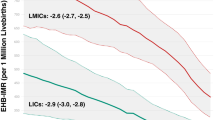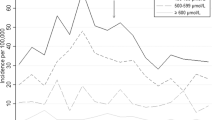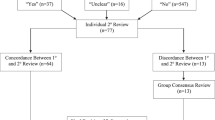Abstract
Breakdown in systems for safe newborn health-care delivery accounts for the majority of kernicterus cases encountered in the United States. Traditional epidemiologic investigations do not track the national incidence of severe hyperbilirubinemia and kernicterus or recognize its recent surge. Innovative investigative strategies are needed to seek more sensitive surrogates for kernicterus (often diagnosed late in infancy) and to overcome the limitations of retrospective continuity of adverse neonatal experiences because of severe hyperbilirubinemia. Root cause analysis of a cohort of infants who manifested kernicterus in the past two decades attests to some of the clinical and health-service barriers encountered by families as they negotiate health care from multiple providers at multiple sites during the first week after birth. Clinicians, health-care organizations, parents, and payors and purchasers of health care were often unaware of the ongoing patterns of care that may have obstructed preventive care. Now, partly based on these analyses, key recommendations have led to clinical usable guidelines for practitioners and have contributed to systems-oriented national guidelines for evidence-based safer management of newborn jaundice.1 Clinician- and family-oriented tool kits have been made available, based on the report presented in this study, to facilitate effective implementation and thus optimize and institutionalize these guidelines (http://www.cdc.gov/jaundice). An informed partnership of parents and clinicians seems to be the most effective strategy to prevent severe neonatal hyperbilirubinemia and ‘near-miss’ cases of kernicterus in the United States.
This is a preview of subscription content, access via your institution
Access options
Subscribe to this journal
Receive 12 print issues and online access
$259.00 per year
only $21.58 per issue
Buy this article
- Purchase on Springer Link
- Instant access to full article PDF
Prices may be subject to local taxes which are calculated during checkout

Similar content being viewed by others
References
Johnson LH, Brown AK, Bhutani VK . System-based approach to management of neonatal jaundice and prevention of kernicterus. J Pediatr 2002; 140: 396–403.
American Academy of Pediatrics Clinical Practice Guideline. Management of hyperbilirubinemia in the newborn infant 35 or more weeks of gestation. Pediatrics 2004; 114: 297–316.
American Academy of Pediatrics, Provisional Committee for Quality Improvement. Practice parameter: management of hyperbilirubinemia in the healthy term newborn. Pediatrics 1994; 94: 558–565.
Bhutani VK, Johnson L, Sivieri EM . Predictive ability of a pre-discharge hour-specific serum bilirubin for subsequent significant hyperbilirubinemia in healthy term and near-term newborns. Pediatrics 1999; 103 (1): 6–14.
Keren R, Luan X, Friedman S, Saddlemire S, Cnaan A, Bhutani VK . A comparison of alternative risk-assessment strategies for predicting significant neonatal hyperbilirubinemia in term and near-term infants. Pediatrics 2008; 121: e170–e179.
Newman TB, Liljestrand P, Escobar GJ . Infants with bilirubin levels of 30 mg/dl or more in a large managed care organization. Pediatrics 2003; 111 (6 Part 1): 1303–1311.
Newman TB, Liljestrand P, Jeremy RJ, Ferriero DM, Wu YW, Hudes ES et al., Jaundice and Infant Feeding Study Team. Outcomes among newborns with total serum bilirubin levels of 25 mg per deciliter or more. N Engl J Med 2006; 354: 1889–1900.
Bhutani VK, Johnson LH, Schwoebel A, Gennaro S . A systems approach for neonatal hyperbilirubinemia in term and near-term newborns. J Obstet Gynecol Neonatal Nurs 2006; 35 (4): 444–455.
Author information
Authors and Affiliations
Corresponding author
Additional information
A report from the Pilot USA Kernicterus Registry (Initiated by Audrey K Brown and Lois Johnson on behalf of the Kernicterus Symposium, Pediatric Academic Societies)Project title: Kernicterus Research and PreventionProject number: AAMC/CDC: MM-04880Institution name: Stanford University School of Medicine and University of PennsylvaniaProject Director: Vinod K Bhutani, MD, FAAP; E-mail: bhutani@stanford.eduCo-investigator: Lois Johnson, MD, FAAPInstitutions Consultants and collaboratorsStanford University David K Stevenson, MD, FAAP Ronald J Wong Judith Y Hall, RN Karen Karp, RN, Emedio M SivieriUniversity of Pennsylvania Rosemary Dworanczyck, Chris Dalin Nancy Kennedy and Ann Schwoebel, MSNPICK (Parents of Infants and Children with Kernicterus) Sue Sheridan, Karen Dixon and all parents of children with kernicterusAmerican Academy of Pediatrics (Chair, Subcommittee for Hyperbilirubinemia) M Jeffrey Maisels, MD, FAAPp4ps (Partnership for Patient Safety) Marty J HatlieUniversity of Minnesota Glenn R Gourley, MDMedical College of Virginia Steven M Shapiro, MDEmory University Augusto Sola, MD, FAAPUniversity of New Mexico Ronald L PolandBrown University William J Cashore, MD, FAAPShaare-Zadek Hospital, Jerusalem Michael KaplanUniversity of Washington Richard P WennbergUniversity of Michigan Steven M Donn, MD, FAAPAmerican Academy of Pediatrics (Quality Improvement Innovation Network) Carol M Lannon Ann R StarkPediatric Academic Societies Members of the Bilirubin ClubInvited Institutional Members of Kernicterus Prevention Partnership Consortium (KPPC) led by the CDC (Drs Marshalyn Yeargin-Allsop and Rachel Avchen)AcknowledgementsThe study for this research was also supported in part by funds from the Sandy Eglin Fund and her generous support of the Pilot USA Kernicterus Registry at Pennsylvania Hospital, Philadelphia. We remember late Audrey K Brown, MD, and value her immeasurable contributions to the initiation and maintenance of the Pilot USA Kernicterus Registry. We thank the parents logged on the newborn jaundice list-serve and our colleagues who contributed their experiences to the registry. We express our gratitude to the newborn jaundice team at the Pennsylvania Hospital and Stanford University for their dedication and support. We also appreciate the administrative support of Donna Spitz (Philadelphia) and Stella Dina- Gengania (Stanford). This study was also supported in part by AAMC/CDC PERT Grant MM-0448.
Rights and permissions
About this article
Cite this article
Bhutani, V., Johnson, L. Synopsis report from the pilot USA Kernicterus Registry. J Perinatol 29 (Suppl 1), S4–S7 (2009). https://doi.org/10.1038/jp.2008.210
Published:
Issue Date:
DOI: https://doi.org/10.1038/jp.2008.210
Keywords
This article is cited by
-
Exchange transfusion safety and outcomes in neonatal hyperbilirubinemia
Journal of Perinatology (2020)
-
Extreme hyperbilirubinemia and rescue exchange transfusion in California from 2007 to 2012
Journal of Perinatology (2016)



